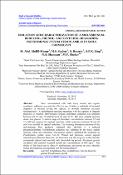Options
Isolation And Characterization Of A Molybdenum-Reducing, Phenol- And Catechol-Degrading Pseudomonas Putida Strain Amr-12 In Soils From Egypt
Journal
Scientific Study And Research-Chemistry And Chemical Engineering Biotechnology Food Industry
Date Issued
2015
Author(s)
AbdEl-Mongy, MA
Shukor, MS
Hussein, S
Ling, APK
Shamaan, NA
Shukor, MY
Abstract
Sites contaminated with both heavy metals and organic xenobiotic pollutants warrants the effective use of either a multitude of bacterial degraders or bacteria having the capacity to detoxify numerous toxicants simultaneously. A molybdenum-reducing bacterium with the capacity to degrade phenolics is reported. Molybdenum (sodium molybdate) reduction was optimum between pH 6.0 and 7.0 and between 20 and 30 degrees C. The most suitable electron donor was glucose. A narrow range of phosphate concentrations between 5.0 and 7.5 mM was required for optimal reduction, while molybdate between 20 and 30 mM were needed for optimal reduction. The scanning absorption spectrum of the molybdenum blue produced indicated that Mo-blue is a reduced phosphomolybdate. Molybdenum reduction was inhibited by the heavy metals mercury, silver and chromium. Biochemical analysis identified the bacterium as Pseudomonas putida strain Amr-12. Phenol and phenolics cannot support molybdenum reduction. However, the bacterium was able to grow on the phenolic compounds (phenol and catechol) with observable lag periods. Maximum growth on phenol and catechol occurred around the concentrations of 600 mg.L-1. The ability of this bacterium to detoxify molybdenum and grown on toxic phenolic makes this bacterium an important tool for bioremediation.
File(s)
Loading...
Name
Isolation And Characterization Of A Molybdenum-Reducing, Phenol- And Catechol-Degrading Pseudomonas Putida Strain Amr-12 In Soils From Egypt.pdf
Size
272.51 KB
Format
Adobe PDF
Checksum
(MD5):460ba142da57581f84d61dbd372551f0